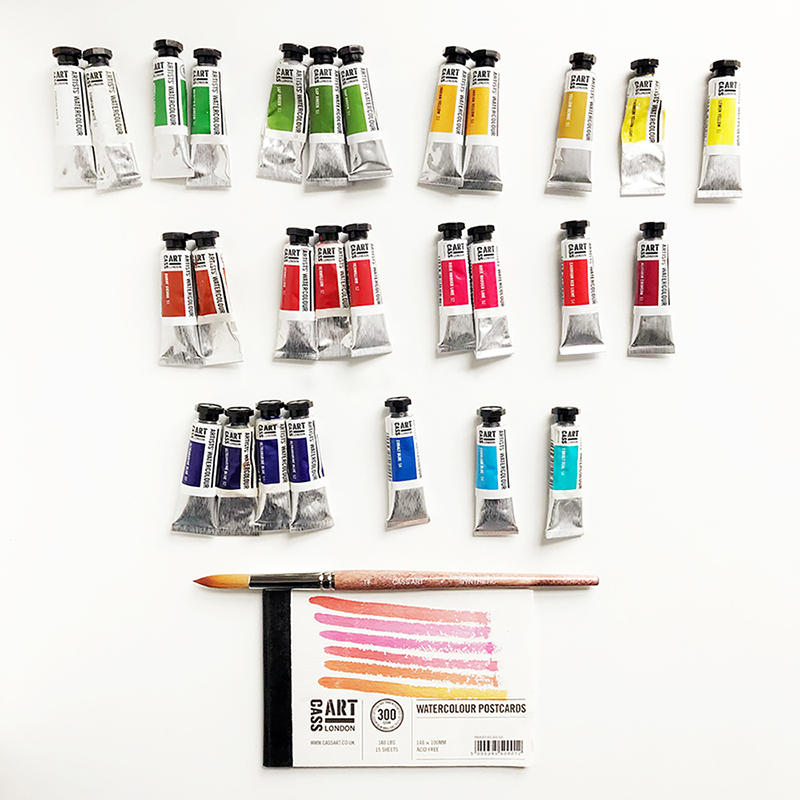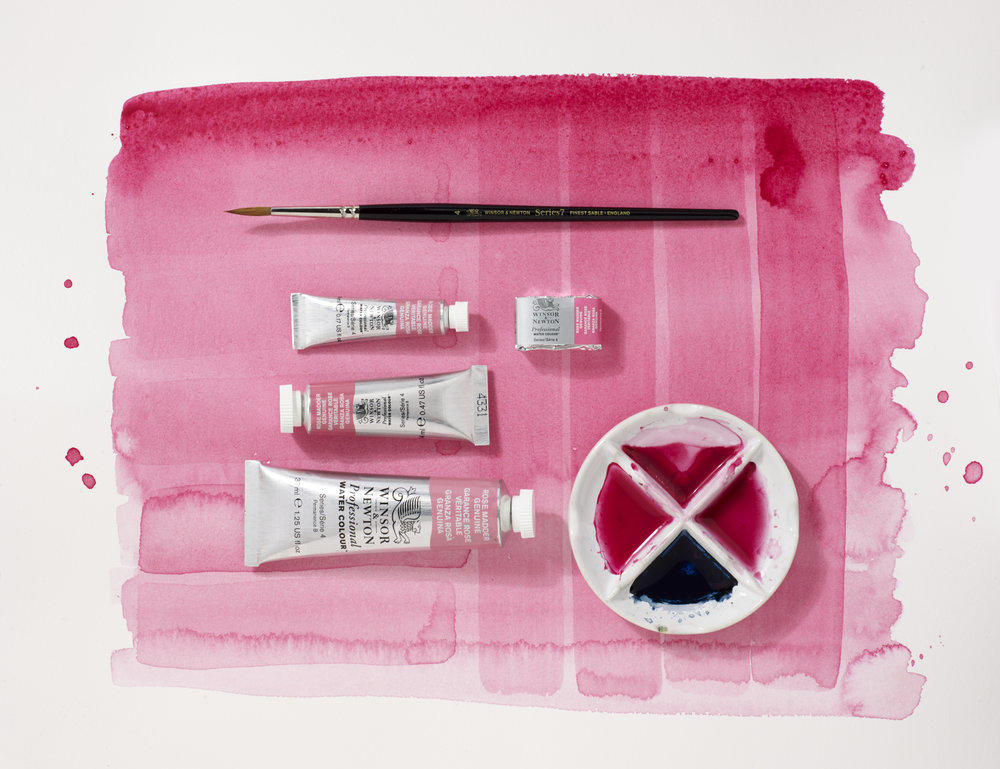Watercolour painting is one of the most accessible and rewarding mediums for artists of all levels. Whether you're drawn to its delicate transparency, fluid blends, or expressive washes, mastering the basics can unlock endless creative possibilities. In this guide, we’ll walk you through the essentials—from choosing your first set of paints to key techniques—so you can start painting with confidence.

Transparency and Luminosity - One of the most appealing qualities of watercolours is their transparency. The pigment allows light to pass through the paint, creating a luminous effect that is nearly impossible to replicate with other mediums.
Flow and Blending - Watercolours rely heavily on the flow of paint and the way pigments blend together on paper. With the right techniques, artists can create smooth gradients, soft transitions, and vibrant color variations that are hard to achieve in other mediums.
Ease of Cleanup - Unlike oil or acrylic paints, watercolours require minimal cleanup. Water is the primary solvent used, making it easier to work with, clean up, and dispose of waste materials. This makes watercolours a favorite choice for artists who prefer a hassle-free painting experience.
Portability - Watercolours are known for their portability. Artists can easily carry a small palette of paints, brushes, and a pad of paper wherever they go. This makes them a popular choice for outdoor or travel sketching.

One initial decision you'll with watercolour is whether to use tubes or pans. Both of these forms of watercolour paint have their unique characteristics and advantages, and understanding the differences between them can help you make an informed choice that best suits your artistic needs. In this blog, we will delve into the distinctions between watercolour tubes and pans, and explore the pros and cons of each.
PROS:
High Pigment Concentration - Watercolour tubes typically contain a higher concentration of pigments, allowing you to achieve vibrant and intense colours with less effort. This is particularly advantageous for artists who seek bold and impactful artworks.
Ideal for Large Works - If you are working on a large canvas or paper, tube paints are often more practical. Their higher pigment load means you'll need less paint to cover a larger surface, making them a cost-effective choice for large-scale pieces.
Longevity - The sealed tubes protect the paint from drying out, resulting in a longer shelf life. This ensures that your investment in high-quality watercolours will last for an extended period.
CONS:
Portability -Tube paints are less convenient for on-the-go painting. Carrying a set of tubes, palettes, and other painting supplies can be cumbersome, which might not be ideal for outdoor or travel sketching.
Drying Time - While the sealed tubes prevent the paint from drying out inside, once squeezed onto your palette, it can still dry quickly. This can be problematic if you work slowly or require an extended period for a particular piece.
PROS:
Portability - Watercolour pans are compact and travel-friendly, making them an excellent choice for artists who enjoy sketching outdoors or while on the move. They fit easily in pockets, purses, or small art kits.
Efficient Drying - Pans have a faster drying time than tube paints, making them perfect for artists who prefer to work quickly. This can be advantageous when layering colours or working on detailed pieces.
Precise Control - The solid, dry form of pans allows for precise control over the amount of paint you pick up with your brush, which is especially useful for intricate details and fine lines.
Easy to Replenish - When you run out of a specific colour in your palette, it's simple to refill the pan with a new watercolour half-pan or tube, ensuring minimal waste and cost-effectiveness.
CONS:
Limited Pigment Concentration - Pans contain less concentrated pigments compared to tube paints, which can make achieving slightly intense colours more challenging. Artists may need to layer or use more paint to achieve the desired vibrancy.
Palette Maintenance - Over time, the colours in a pan palette may mix or become contaminated with one another, potentially affecting the purity of your colours. Frequent cleaning and upkeep of your palette are necessary to maintain colour integrity.
In conclusion, the choice between watercolour tubes and pans is a matter of personal preference and practicality. Your decision should align with your artistic style, needs, and intended use. If you require intense pigments, work on large pieces, or prefer studio painting, tubes may be your preferred choice!
The wet-on-wet technique involves applying paint onto a surface already wet with water. This creates a magical interplay of colours, allowing them to bleed and blend into one another, forming soft washes and ethereal gradients.
Tips for Success:
Prepare your paper: Lightly dampen your watercolour paper with clean water. A spray bottle offers good control. Aim for even moisture, avoiding puddles.
Lay down your base colours: Quickly drop washes of colour onto the wet surface. The colours will naturally blend and create unique patterns.
Limit your colours: Using too many colours can lead to muddied results. Start with a few harmonious colours and experiment with their interactions.pen_spark
*Common Mistakes:
Overworking the wash: Resist the urge to keep adding paint once the paper is wet. Let the water do the work of blending.
Using too much water: Excessively wet paper can lead to loss of control and weak washes.
The wet-on-dry technique is pretty self explanatory - it involves applying wet paint onto a dry watercolour surface. This allows for more control and detail compared to wet-on-wet.
Tips for Success:
Let your base dry completely: Patience is key! Ensure the paper is entirely dry before applying wet paint.
Layer for depth: Build up colour by applying thin washes, allowing each layer to dry before adding the next.
Define details: Once the base colours are established, use wet-on-dry to add sharper details and crisp lines.
Once your watercolour work is completely dry, it's time to find it a safe haven. Here's what to consider for long-term storage:
Light matters: Ultraviolet (UV) light can cause fading over time. Store your artwork away from direct sunlight and strong artificial lights. Opt for a cool, dark space like a portfolio or a drawer.
Climate control is key: Ideal storage environments have moderate temperature and humidity levels. Aim for a range of 68-77°F (20-25°C) and 45-55% relative humidity. This helps prevent warping, cracking, and mould growth.
Archival essentials: Invest in acid-free and archival-quality materials for storing your artwork. This includes folders, mat boards, and storage boxes. Regular cardboard can contain acids that can damage your artwork over time.
Stacking Savvy
For multiple artworks, avoid stacking them directly on top of each other. This can cause warping and damage to the pigments. Here are some safe stacking methods:
Interleave with spacers: Place sheets of acid-free tissue paper between each artwork before stacking them loosely in a portfolio.
Box it up: Use individual archival boxes for each piece, especially for more delicate works on paper.

Watercolour paper comes in various textures, including rough, cold-pressed (medium), and hot-pressed (smooth). The choice of texture depends on your painting style and personal preference.
Hot-Pressed (HOT): Provides a fine and smooth surface, perfect for intricate details and controlled washes. Artists who prefer precise and detailed work often opt for hot-pressed paper.
Cold-Pressed (NOT): Strikes a balance between rough and smooth textures. This surface is versatile and accommodates different painting styles, making it a popular choice for many watercolour artists.
Rough: As I'm sure you've guessed is the most textured watercolour paper. The deep pits in the paper are brilliant if you want to get the most out of the granulation of your watercolour paints. This heavily textured paper is well suited to those with a loose watercolour painting style.
Weight
As we've learned, texture is an essential factor in determining the type of watercolour paper you need. But it’s just as important to select a high-grade paper with the right weight. A watercolour paper's GSM is the indicator of the paper’s weight. GSM is grams per square metre and refers to the thickness of each individual sheet of paper. The lower the gsm, the more the paper will buckle as it dries. The most common watercolour paperweights are 190 gsm, 300 gsm, 356 gsm, and 638 gsm.
For information on finding the best watercolour for you, check our comprehensive guide here.
Hopefully this guide was of help you on your watercolour journey! Why not get started and explore our full range of watercolour materials here.